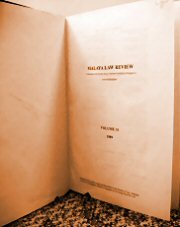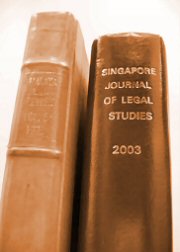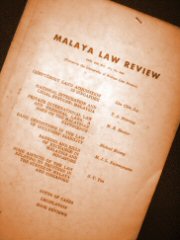|
Archive |
2396 records match your query:
| 101. | SEPTEMBER 2020 Issue | p.581 | |
| | Certain Drafting Mysteries Concerning the New Insolvency, Restructuring and Dissolution Act
Kiu Yan Yu • [2020] Sing JLS 581 (Sep)The Insolvency, Restructuring and Dissolution Act 2018 caps the recent round of reforms to Singapore's insolvency regime, and represents the immense work that has been done to turn Singapore into an international centre for debt restructuring. Many aspects of the Act are new to Singapore and have elicited widespread discussion, such as the restrictions placed on ipso facto clauses. However, one area that has been overlooked is the drafting of provisions that were in place in one form or another under the old regime. The modification and transposition of these provisions to the omnibus act introduced new drafting oddities, rendering some of the provisions difficult to interpret. This paper aims to highlight some of these drafting issues, clarify the meaning of the relevant provisions, and provide some thoughts on how similar issues can be avoided in the future.
| | 102. | SEPTEMBER 2020 Issue | p.601 | |
| | Open Banking and Libra: A New Frontier of Financial Inclusion for Payment Systems?
Andreas Kokkinis and Andrea Miglionico • [2020] Sing JLS 601 (Sep)A wide range of digital initiatives have an impact on 'financial inclusion', ie, access to banking services both for underbanked and low-income customers. Promoting financial inclusion using virtual platforms in low and middle-income countries enables reaching vulnerable and excluded customers. This article examines the new frontiers of open banking and cryptocurrencies for payment systems from the perspective of inclusive financial development. The possibility for technology-based change in the financial markets is demonstrated in the online delivery of banking services and in the business models and operations of intermediaries that provide them. Enhancing the appropriate public policy on financial data and the availability of 'open data' for use by other firms and investors represent the main challenges for regulators. This article argues that there is a public interest in data access that requires coordination at industry level and may also require regulatory intervention to ensure the governance of data technologies.
| | 103. | SEPTEMBER 2020 Issue | p.630 | |
| | COVID-19 in Singapore: 'Responsive Communitarianism' and the Legislative Approach to the "Most Serious Crisis" Since Independence
Darius Lee • [2020] Sing JLS 630 (Sep)The Singapore government has called the COVID-19 pandemic "the most serious crisis" that Singapore has faced since Independence. However, Singapore did not issue a Proclamation of Emergency. Instead, it adopted a 'legislative model' of emergency powers, addressing COVID-19 through ordinary legislation, including and especially the new COVID-19 (Temporary Measures) Act 2020 . Despite the sweeping nature of the powers thereunder, the government has exercised a calibrated approach in its measures, shaped by communitarian norms and high level of responsiveness towards the needs of members of the Singapore community, albeit not without its weaknesses. This article thus makes the case that Singapore's response to COVID-19 has been characterised by two main features: a legislative emergency in law and 'responsive communitarianism' in practice. It argues that COVID-19 has seen the further concentration of executive power where the law is increasingly instrumentalised as a tool towards social and political priorities.
[Full Text]
| | 104. | SEPTEMBER 2020 Issue | p.665 | |
| | Upholding Responsible Government: Legal and Political Controls on the Prorogation Power in Singapore
Seow Zhixiang • [2020] Sing JLS 665 (Sep)This article argues that judicial control of the prorogation power in Singapore should be confined to enforcing the Constitutional provisions that directly or indirectly regulate the power - the most important being the 6-month limit on the interval between sessions of Parliament. Beyond the Constitutional provisions, the Constitutional principle engaged in an exercise of the prorogation power is responsible government, which is turned on its head when Parliament is prorogued on the advice of a Prime Minister who does not command its confidence. Responsible government is secured not by legal controls but by political controls, ie the reserve power of the President to dismiss a Prime Minister who does not command confidence. This power can be operated to avoid, or to reverse, a prorogation advised by a Prime Minister who does not command the confidence of Parliament. There is no therefore need for judicial control of prorogation beyond enforcing the relevant Constitutional provisions.
| | 105. | SEPTEMBER 2020 Issue | p.681 | |
| | Mobile Intellectual Property and the Shift in International Tax Policy from Determining the Source of Income to Taxing Location-Specific Rents: Part One
Daniel Shaviro • [2020] Sing JLS 681 (Sep)In recent decades, a number of fantastically successful, mainly American, MNEs - led and epitomised by the "Four Horsemen", Apple, Amazon, Facebook and Google, but also extending beyond the tech sector - have earned huge profits, while paying very low global taxes, through their use of IP. Since intellectual property, in contrast to tangible property, generally lacks a clear location, it empowers corporate tax avoidance at the expense of both the production countries where the MNEs' high-value owner-employees live, and the market countries where their customers live. This two-part article assesses the challenges posed for countries' international tax systems by the rise of mobile intellectual property, including but not limited to the case where it is embodied in a digital platform. Part One in this issue assesses the challenges posed for the traditional income tax concept of source, and for the OECD's proposed focus on the site of "value creation". Part Two in the next issue will focus on proposals to shift taxing rights towards market jurisdictions that may enjoy location-specific rents with regard to the MNEs' access to their consumers, including via the use of DSTs.
| | 106. | SEPTEMBER 2020 Issue | p.702 | |
| | All The World's A Stage, But What is A Dramatic Work?
David Tan and Samuel Lim • [2020] Sing JLS 702 (Sep)Modern conceptions of dramatic entertainment have expanded to include diverse and previously inconceivable forms. The elements of apparent spontaneity in popular television shows like MasterChef, The Amazing Race and The Voice appear to be at odds with the traditional requirements of a predetermined script—which is commonly understood to be necessary for copyright protection of a "dramatic work". Other forms of performances such as improvisation theatre, animal acts, fireworks and synchronised drones only add to a cacophonous collection that do not fit into our current state of copyright law that demands categorical recognition of works. This article explores, through a comparative analysis of developments in a number of Commonwealth common law jurisdictions, what may and should qualify as a dramatic work in Singapore in the 21st century.
| | 107. | SEPTEMBER 2020 Issue | p.726 | |
| | The Tainting Doctrine in Singapore Conflict of Laws
Rennie Whang • [2020] Sing JLS 726 (Sep)In Singapore conflict of laws, the tainting doctrine applies where a contractual claim governed by Singapore law is not itself unenforceable for illegality or public policy, but is sufficiently connected to a transaction which is so unenforceable. However, the mechanism of this doctrine—as articulated in the English Court of Appeal decision of Euro-Diam Ltd v Bathurst Ltd —is today uncertain due to, inter alia , its use of domestic illegality principles which no longer apply. This paper suggests two areas of clarification. First, it explores whether the doctrine should be seen an application of the proper law of the contract or the law of the forum. Second, it introduces a possible approach as informed by the test in tainting by domestic illegality, which may be applied where the contract sought to be enforced is governed by Singapore law.
| | 108. | SEPTEMBER 2020 Issue | p.748 | |
| | Case and Legislation Notes: Impossible Attempts and the Punishment of Intent— Han Fang Guan v Public Prosecutor
Chan Wing Cheong • [2020] Sing JLS 748 (Sep)This comment reviews the new "two-stage framework" developed by the Singapore Court of Appeal in the case of Han Fang Guan v Public Prosecutor for impossible attempts under the Misuse of Drugs Act . The new framework clarifies the law and it is suggested that the approach should be adopted for all other criminal laws as well.
| | 109. | SEPTEMBER 2020 Issue | p.756 | |
| | Case and Legislation Notes:Opening the Door to Fickle-Minded Guilty Pleas?— Public Prosecutor v Dinesh s/o Rajantheran
Goh Teng Jun Gerome • [2020] Sing JLS 756 (Sep)Unlike applications to retract guilty pleas, accused persons are not required to provide valid and sufficient reasons when qualifying their guilty pleas in mitigation. In Criminal Reference No. 5 of 2018, the Court of Appeal held that section 228(4) of the Criminal Procedure Code allows accused persons to qualify their guilty pleas in mitigation to the extent that it amounts to a retraction of their guilty pleas unless there is an abuse of the court's process. This comment considers the desirability of the current law and suggests that the law applying to such withdrawals of guilty pleas should be amended.
| | 110. | SEPTEMBER 2020 Issue | p.769 | |
| | Book Reviews: International Sales Law: A Guide to the CISG by Ingeborg Schwenzer, Christiana Fountoulakis and Mariel Dimsey
Gary F Bell • [2020] Sing JLS 769 (Sep)This is the third edition of this excellent casebook on the United Nations Convention on Contracts for the International Sale of Goods ("CISG"). It is a very useful teaching tool, which is its main purpose. It comes, for example, with questions for the students on each article of the CISG, with 140 pages of answers to these questions at the end of the book. This casebook could also be very useful to the practitioner unfamiliar with the CISG as it provides edited cases on the CISG from many jurisdictions, some comparisons to other international instruments and to some domestic laws, and some views from the CISG Advisory Council and some doctrinal authors.
| |
|
|


 |







